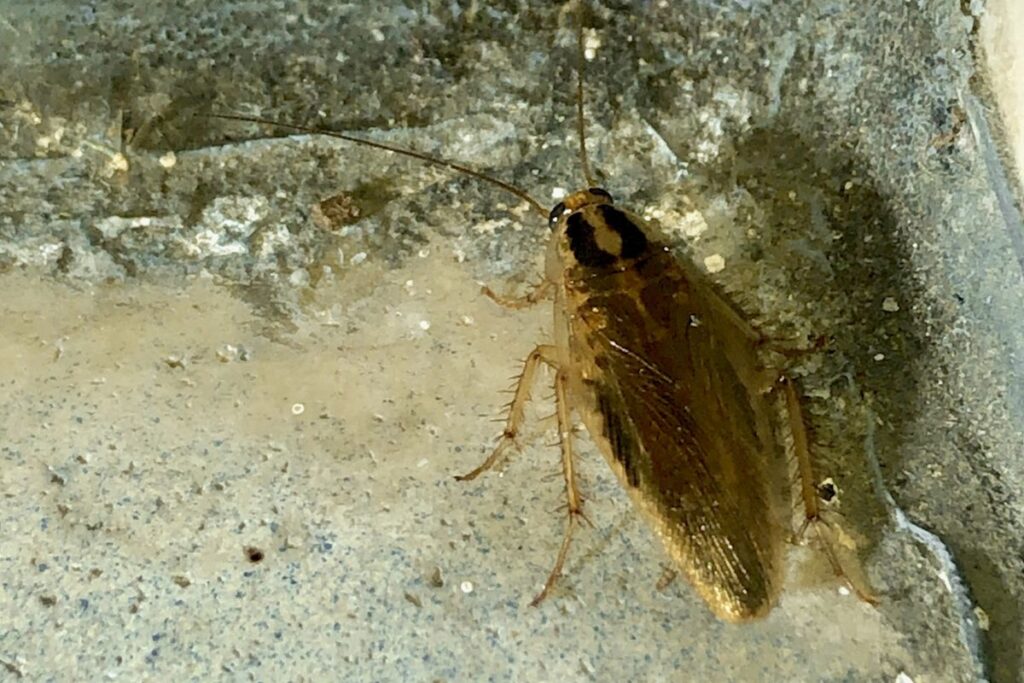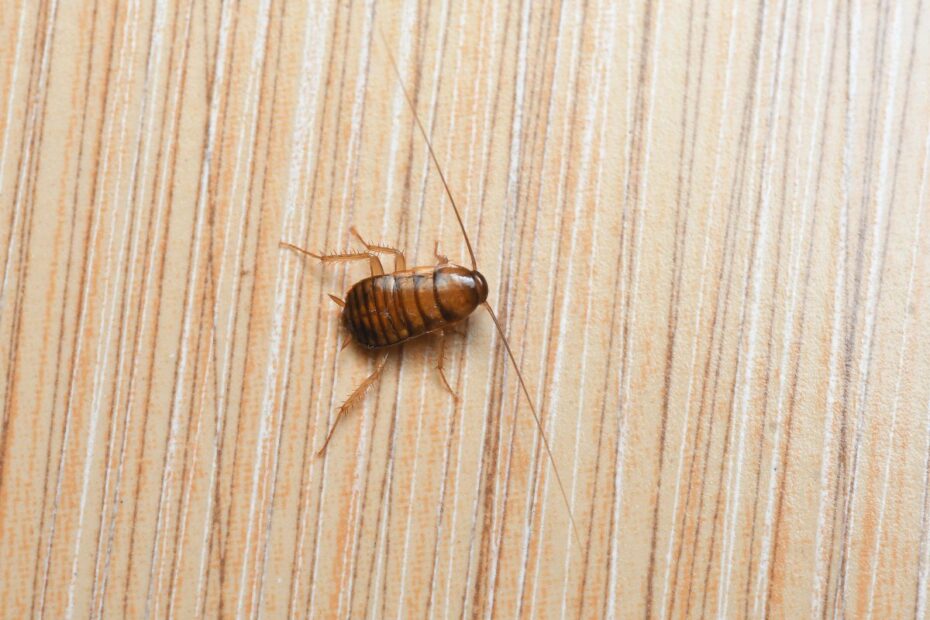If you have ever had the misfortune of dealing with a small cockroach infestation, then you know just how annoying and difficult they can be to get rid of. But don’t despair, there is hope! With a little knowledge and the right tools, you can get rid of these pests for good. Here’s what you need to know about small cockroaches and how to get rid of them.
What Do Small Cockroaches Look Like?
The three most common cockroaches found in homes are the German cockroach, the American cockroach, and the Oriental cockroach. However, there are many other species of small roaches that may find their way into your home. These include:
- Brown-banded cockroaches
- Asian cockroaches
- Baby roaches or nymphs
Let’s take a quick look at what each of these small roaches looks like:
Brown-Banded Cockroach

The brown-banded cockroach is one of the smaller roach species. Adults grow to be about 1/2 an inch long. They are light brown in color with two dark brown bands that run across their wings. These small roaches are often found in warm, humid areas of the home, such as kitchens and bathrooms.
Asian Cockroach

The Asian cockroach is very similar in appearance to the German cockroach. Adults grow to be about 1/2 an inch long and are dark brown in color. They are often found in damp areas, such as basements or near water sources.
Baby Roaches or Nymphs

Baby roaches or nymphs are small versions of adult roaches. They range in size from 1/8th of an inch to 1/2 an inch long. Nymphs are typically dark brown or black in color and have undeveloped wings.
Why Cockroaches at Home are a Problem
One of the main reasons why cockroaches are a problem at home is that they can carry and spread diseases. Cockroaches can contaminate food and surfaces with bacteria and other germs, which can lead to illness in humans. They are also known to trigger allergies and asthma attacks in some people.
Cockroaches can also cause damage to your home. They are attracted to a variety of household materials, including paper, glue, and even electrical wiring. They can chew through these materials, which can lead to costly repairs.
In addition to being a health and property hazard, cockroaches can also be a major nuisance. They are most active at night, which means that they can be difficult to spot during the day. They are also skilled at hiding and can squeeze into small cracks and crevices, making them difficult to get rid of once they have infested a home.
Cockroaches are often brought into homes inadvertently in boxes or luggage. Once they’re inside, they’ll hide in dark, warm places like baseboards, behind appliances, or inside cabinets. If you see one cockroach, there’s a good chance there are many more hiding nearby.
What Do They Commonly Get Mistaken For
Cockroaches are a common household pest that can be mistaken for other insects due to their similar appearance and behavior. Here are some common insects that people often mistake for cockroaches:
- Beetles: Cockroaches and beetles can have a similar appearance, especially if the beetle has a hard, shiny exoskeleton. However, beetles generally have longer antennae and a more rounded body shape than cockroaches.
- Waterbugs: Waterbugs, also known as palmetto bugs, are often mistaken for cockroaches due to their size and shape. However, waterbugs are typically found near sources of water and have a more flattened body shape than cockroaches.
- Crickets: Crickets and cockroaches can both have long, thin bodies and multiple legs, which can make them appear similar at a glance. However, crickets are typically smaller than cockroaches and have a more slender body shape. They also have long antennae and wings, which cockroaches do not.
- Termites: Termites are often mistaken for cockroaches due to their similar size and shape. However, termites have a more rounded head and a smaller waist than cockroaches. They are also typically found in wood or wood structures, whereas cockroaches can be found in a variety of environments.
It is important to accurately identify the type of insect you are dealing with in order to effectively eliminate and prevent infestations. If you are unsure what type of insect you are dealing with, it is best to consult a pest control professional for accurate identification and treatment recommendations.
How Do Small Cockroaches Get in the House
Once cockroaches establish themselves in an environment, they can be very difficult to get rid of. These pests are known for their durability, as they can survive without food for a month and without water for up to two weeks. Cockroaches are also prolific breeders and can produce up to 50 offspring in a single year.
One of the best ways to prevent an infestation is to keep these pests from getting into your home in the first place. Here are some of the most common entry points for cockroaches:
- Cracks and gaps in windows and doors
- Holes in pipes and vents
- Hitching a ride on furniture and other items
If you do find yourself with a small cockroach problem, there are some things you can do to get rid of them. Try these tips:
- Eliminate their food and water sources by cleaning up any spills or messes immediately, sealing up food in tightly-closed containers, and fixing leaks.
- Remove hiding places by decluttering your home, vacuuming regularly, and sealing cracks and gaps.
- Use traps or baits specifically designed for cockroaches. Please note that these products may not be effective against all cockroach species.
Common Areas of Cockroach Infestations
Cockroaches are attracted to damp, dark places where they can find food and shelter. Here are some common areas of cockroach infestations at home:
Kitchens
Kitchens are a common area for cockroach infestations because they offer a steady supply of food and water. Cockroaches are attracted to crumbs, spills, and other food debris, as well as moisture from sinks, dishwashers, and other sources.
Bathrooms
Like kitchens, bathrooms are a common area for cockroach infestations due to the presence of water and moisture. Cockroaches are attracted to damp, humid environments and can often be found in and around sinks, showers, and bathtubs.
Basements
Basements are another common area for cockroach infestations due to their damp, humid environment. These insects can also be attracted to the presence of pipes, wiring, and other materials in basements.
Garages
Cockroaches can also infest garages, especially if they have access to food, water, and hiding places. These insects are attracted to clutter and debris, as well as materials like cardboard boxes and paper products.
Other areas
Cockroaches can infest other areas of your home as well, including bedrooms, living rooms, and even attics and crawl spaces. They can spread quickly throughout a home, so it is important to take steps to prevent and control infestations as soon as possible.
How to Get Rid of Small Roaches for Good
Cockroaches are one of the most common household pests, and they can be very difficult to get rid of. If you have small roaches in your home, it is important to take action immediately to get rid of them for good. Here are some tips for how to identify and get rid of small cockroaches:
Look for Signs of Roaches
Cockroaches can be hard to spot, but there are some telltale signs that you may have a problem. Look for droppings, egg cases, or molted exoskeletons in dark corners or on countertops. You may also see roaches themselves, which are dark brown or black insects about 1/2 to 5/8 inch long.
Eliminate Potential Food Sources
Roaches are attracted to food, so one of the best ways to get rid of them is to eliminate their food sources. Make sure all food is properly sealed and stored, and clean up any crumbs or spills immediately. Taking out the trash regularly will also help deter cockroaches.
Try a DIY Solution
If you don’t want to use harsh chemicals, there are some natural solutions you can try. Boric acid powder is a popular choice for getting rid of cockroaches; just make sure to keep it out of reach of children and pets. You can also make your own roach traps using glue traps or banana peels.
Use Gel Baits
Gel baits work by attracting cockroaches with a scent that repels them away from the bait. The gel bait sticks to surfaces where cockroaches live, such as walls, floors, ceilings, and furniture, and then releases its repellent smell when disturbed. This method works best against adult cockroaches, but it can also be used to kill baby roaches.
Eliminate Water Sources
Water is essential for cockroaches’ survival, so eliminating potential water sources can help reduce the number of roaches in your home. Keep sinks, tubs, toilets, and faucets free of standing water, and empty containers of water frequently.
Deprive Roaches of Hiding Spots
Cockroaches love to hide, so removing potential hiding spots can help keep them off your property. Clean up clutter around your house, remove old mattresses and box springs, and vacuum up dust bunnies.
Use Bombs / Foggers
Foggers and bombs are two effective tools for killing cockroaches. Both work by releasing toxic fumes into the air, which kills cockroaches within minutes. Use these methods only if you know what type of roaches are present in your home.
Call an Exterminator
If DIY methods aren’t working, it’s time to call in the professionals. A pest control company can help you identify the source of your infestation and get rid of the cockroaches for good using stronger products and methods.
Where do cockroaches usually lay eggs?
Cockroaches are insects that lay eggs in a variety of places, depending on the species and the environment. Here are some common places where cockroaches lay their eggs:
- Egg cases: Many species of cockroaches lay their eggs in an egg case, also known as an ootheca. The ootheca is a hardened, protective casing that contains several eggs. The female cockroach carries the ootheca with her until the eggs are ready to hatch, at which point she deposits it in a safe, hidden location.
- Crevices and cracks: Cockroaches often lay their eggs in small crevices and cracks, especially in areas that are dark, humid, and close to a food source. These insects may lay their eggs behind appliances, under sink cabinets, or in other tight, hidden spaces.
- Cardboard boxes: Cockroaches are attracted to cardboard boxes and other paper products, and may lay their eggs in these materials. This is especially common in garages, basements, and other storage areas where cardboard boxes are often stored.
- Potted plants: Some species of cockroaches are attracted to potted plants and may lay their eggs in the soil or other materials within the pot. This can be a common problem in greenhouses, conservatories, and other environments where potted plants are prevalent.
Final Words
The best way to prevent roach infestations is to keep them out of your home in the first place. Keep your house clean, dry, and free from clutter. Use insecticides only when absolutely necessary. And if you find yourself dealing with a roach infestation, contact a professional pest control service immediately. They will have the right tools and knowledge to get rid of the pests once and for all!
